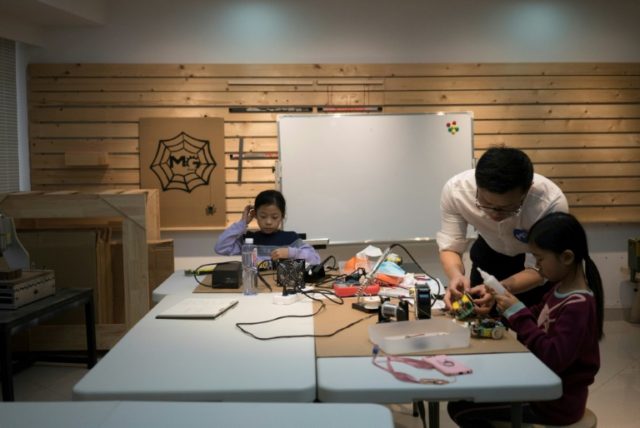Shenzhen (China) (AFP) – Engineers, computer programmers and children tinker with self-made radio-controlled toy cars and robotic arms in China’s southern city of Shenzhen, home to “makers” who belie the country’s reputation as a hub for technology copycats.
The group works in a special space inside a high-rise in a city considered a nerve centre for the “maker movement” of tech whizzes who invent, design and make their own gadgets and devices from scratch.
China is trying to shed its notoriety as a hub for counterfeit goods, a battleground in an ongoing trade dispute with the United States, which is threatening to hit Chinese electronics and other high-end industry with steep tariffs for the “theft” of intellectual property.
The Shenzhen government has doled out $145 million in grants to lure thousands of Chinese and foreign entrepreneurs, and tens of millions more to fund “maker spaces” and activities to encourage innovation.
At the “MG Space”, a wall is covered by shelves with meticulously labelled bins containing assorted pieces of wood and foam, circuit boards, wires, soldering kits, plastic parts and joiners for communal use.
“I’m designing a pulley system that can support a lot of weight,” 11-year-old Li Zhonghan told AFP, without taking his eyes off a 3D modelling programme on his computer.
Once their blueprints are ready, the makers send their plans to a 3D printer and laser cutter to make their designs a reality.
Yue Lingyu, vice manager of “MG Space,” which is privately funded, said it is important to give children and youth opportunities to collaborate on projects with professionals.
“The tutors here don’t see the kids as their students — they view each other as colleagues,” she told AFP.
– Fighting ‘copycat’ culture –
“Makers” pride themselves on coming up with new ideas, and they expect fellow makers to give them due credit for inventions.
This is a departure from the so-called “shanzhai” culture in China, where counterfeiters produce increasingly high-quality replicas of everything from computers to handbags to famous paintings.
Eight years ago, two brothers in Shenzhen invented the “Apple Peel”, a set of attachments that convert an iPod Touch into a fully functional iPhone that can make calls and send text messages.
China has slowly evolved from “shanzhai” to grey areas like Apple Peel and original technologies such as dockless shared bicycles.
Shenzhen went from being a manufacturing hub for mainly foreign firms to making mobile phones, drones and other gadgets for Chinese firms and start-ups.
But a survey of US businesses by the American Chamber of Commerce shows IP infringement continues to be a top challenge for some in China, citing inadequate laws and difficulty prosecuting cases.
Intellectual property issues have vexed Chinese companies, too. New IP courts have been created to stop the thefts.
“In China, trends spring up and companies copy each other. Especially for cases where the ideas require a low level of technology, it’s hard to say who came up with it first,” said Wu Nan, founder of AllTechAsia, which tracks Chinese technology trends.
Matthew Murphy, managing partner at the Beijing-based MMLC firm, which specialises in IP, says there are too many obstacles to bringing cases to court.
“The laws are fine but many innovators look at how much trouble and cost may be involved in IP enforcement and they get concerned. The requirement of notarised/legalised Powers of Attorney and other documents adds a level of cost and slows things down a lot,” he told AFP.
– Hacking the subsidy game –
Another problem is that the wealth of government subsidies available can lead to a concentration of start-ups in areas where there isn’t enough demand, critics say.
Christopher Balding, economics professor at Peking University in Shenzhen, has observed entrepreneurs making decisions based on what subsidies are available regardless of whether the company actually intended to bring their proposed products to market.
“For example, the government decided that robots were a big thing and there was a lot of funding, so everyone began making robots. While there is significant new robot adoption in China, Beijing is investing vastly more than needed,” Balding said.
Some say public funds for makers are not being wisely spent.
“Maker spaces get so much money from the government and they’re competing with each other for members, but there are so many that some are completely empty,” Wu said.
James Simpson, founder of the private “Steamhead” makers’ education hub in Shenzhen, said there are enough maker spaces now and the priority should be to get people to use them.
“In China there is huge interest and an increasing number of resources to turn creative skills into a sustainable business, but not so many chances for people to have interactions to access new experiences and learn from others,” he said.
But the satisfied parents and kids at MG Space are more optimistic about China’s innovative skills.
“China has come a long way from rote learning in all the schools, especially here in Shenzhen where teachers really want to give kids practical skills,” said Yang Hong, a mother of two.
“I like to make stuff,” said her daughter, 8-year-old Yao Xirou. “I don’t know the job I want yet, but I just want to have fun.”

COMMENTS
Please let us know if you're having issues with commenting.